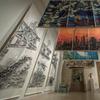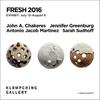Featured 19th Century Painter: John Ross Key (American 1837 – 1920) ( aka John R Key )
- July 05, 2021 08:21
John Ross Key was born in Hagerstown, Maryland, the son of U.S. Attorney for the District of Columbia and grandson of Francis Scott Key, who penned the lyrics to our national anthem, "The Star-Spangled Banner". From 1852–56 young key served as a draftsman with the United States Coast Survey. The Survey hired only the best scientists and naturalists and Key served with artists James McNeill Whistler and Gilbert Munge to make engravings of the features of the eastern United States seaboard. Artist John Ross Key was largely self-taught, but circa 1856 he was in New York City and it is thought that he may have studied at the National Academy of Design. In February 1859, his father was killed in cold blood by Daniel Sickles, U.S. Representative from the New York (and later a Union General during the Civil War), over the elder Key's affair with Sickles's wife. In May of that year, 19th century artist John Ross Key joined the Lander Oregon Trail expedition of 1859, the primary goal of which was to survey the road that Lander had blazed in 1858. Lander was politically well-connected in Washington, D.C. and a member of the newly formed Washington Art Association. It is no wonder that the 1859 expedition included a complement of artists, an investment also supported by the U.S. Government. In addition to Key, artists included Albert Bierstadt, Henry Hitchings, and Francis Seth Frost. At the start of the Civil War, Key joined the Confederacy, serving with the Corps of Engineers in Charleston, South Carolina. In 1863 he was off the coastline of South Carolina where he witnessed and documented the siege of that city. 1865 found him sketching along the slopes of Cheat Mountain, the new state of West Virginia. In 1866 Key lived in New York City where he first exhibited at the National Academy of Design. The following year, Louis Prang, founder of L. Prang and Company, sent him to California to paint a series of landscapes for his lithographic prints. He returned briefly to Baltimore, Maryland and in 1867 exhibited at the Pennsylvania Academy of the Fine Arts, Philadelphia, Pennsylvania. Apparently quite taken with the scenery of California, he returned there in 1869 to sketch and paint the scenery of Yosemite, Carmel, Lake Tahoe, the Sierra Nevada mountains, the Golden Gate, Point Lobos and the giant Sequoias. Circa 1871 Key moved to Boston, Massachusetts and exhibited at the Boston Art Club (1875-1878). He made excursions into neighboring New Hampshire to paint the White Mountains. In 1873, the now recognized artist, traveled to Munich, Germany and Paris, France to formally study art. When Key returned from his studies abroad in 1875, he worked in Chicago, St. Louis, New York and Baltimore, before returning to Boston. From 1904–17 key lived in Washington, D.C. and for a short while in Baltimore, before moving again to Boston for a short time. Key died in Baltimore in 1920. Key painted the grand architecture erected for the 1893 World's Columbian Exhibition (Chicago, 1893); Trans-Mississippi and International Exposition 1898 (Omaha, Nebraska, 1898) and The Louisiana Purchase Exhibition (St. Louis, 1904). He exhibited at the National Academy of Design (1866-1879); The Pennsylvania Academy of Fine Arts; The Boston Athenaeum; Mechanics Institute, San Francisco; The Boston Art Club (1875-1878); Corcoran Gallery (1908); and Society of Independent Artists (1917). He was a member of the Society of Washington Artists and the Boston Art Club.
Call now to talk about your interest in this John Ross Key (American 1837 – 1920) painting: 724-459-0612 - Jerry Hawk, Bedford Fine Art Gallery




















![Peter Paul Rubens (Flemish, 1577–1640), After Titian (Tiziano Vecelli) (Italian [Venetian], c. 1488–1576), Rape of Europa, 1628–29. Oil on canvas, 71 7/8 x 79 3/8 in. Peter Paul Rubens (Flemish, 1577–1640), After Titian (Tiziano Vecelli) (Italian [Venetian], c. 1488–1576), Rape of Europa, 1628–29. Oil on canvas, 71 7/8 x 79 3/8 in.](/images/c/e2/2e/Jan20_Rape_of_Europa100x100_c.jpg)
